|
|
Posted By Administration,
Thursday 13 February 2025
|
Author: Alessandro Bettini
The Galilean Academy of Sciences, Letters and Arts in Padua is now an EPS Historic Site, in honour of Galileo Galilei.
The
plaque unveiling ceremony took place on January 18, 2025, conducted by
the President of the European Physical Society (EPS), Prof. Mairi
Sakellariadou, and the President of the Academy, Prof. Giovanna Zaniolo,
during the annual academic Galilean Day, in the presence of the
academicians and of the public (Fig. 1).

Fig. 1: Unveiling
of the plaque. FLTR: Angela Bracco, President of the Italian
Physical Society (SIF), Mairi Sakellariadou ,
President of the European
Physical Society (EPS) and Giovanna Zaniolo, President of the Accademia
Galileiana. Credits Accademia Galileiana.
The event began
with an introduction by Prof. Zaniolo, including the reading of
congratulatory messages from the Senator Maria Elisabetta Alberti
Casellati, Minister for Institutional Reforms and Regulatory
Simplification, and the President of the Veneto Region, Luca Zaia. This
was followed by a brief explanation by myself of the motivations for the
designation (see below), as well as remarks by Prof. Sakellariadou and
Prof. Bracco, President of the Italian Physical Society (SIF), on the
role of their respective Societies.

Fig. 2: The emblem of the Accademia Galileiana. Credits Accademia Galileiana.
The
Academy is the oldest among the scientific ones still active in Italy,
having been founded on November 25, 1599, under the name Accademia dei Ricovrati. Its motto, Bipatens animis asylum—inscribed on its emblem (Fig. 2)—is a verse from Boethius, inspired in turn by the allegoric description in Homer’s Odyssey
of the Cave of the Naiads, with its two entrances. The motto was chosen
to symbolize a refuge for the convergence of contemplative life and
active life, between theoretical speculation and practical application.

Fig. 3: “Sala Guariento”, the meeting room of the Accademia. Credits Accademia Galileiana
The
ceremony took place in the meeting room of the Accademia (Fig. 3).
This, initially the Chapel of the Carrarese Palace, was magnificently
decorated by Guariento di Arpo around 1350, one of the UNESCO World
Heritage Sites. At the time, Padua was under the ruling of the Carrarese
family, still independent of Venice, that will conquer it in 1405. Born
five years after the departure of Giotto from Padua, Guariento dealt
with the indelible footprint of the Tuscan genius, while developing an
original pictorial language echoing the culture of his city. In the
frescoes of the Chapel, he focuses on the divine power, narrating
episodes from the Bible. The one in Fig. 4 is from the Book of Daniel,
on the Babylonian exile of the Jews. Having three young Jews refused the
order of Nebuchadnezzar to worship a statue, the king commanded to hurl
them into a fiery furnace, but they were saved by the Angel of the
Lord. In the painting, the king appears astonished, above the disordered
mass of terrified soldiers, in stark contrast to the solemn calmness of
the angel and the three victims, emerging unscathed from the furnace.

Fig. 4: The Three Young Men in the Fiery Furnace, by Guariento di Arpo. Credits Accademia Galileiana
The name of the Accademia was changed to Galileiana
in recent years, to celebrate Galileo Galilei as one of its founding
members. We read his name in the minutes of the first session on
November 25, 1599, the only scientist amongst university professors of
law and of philosophy, men of letters, learned nobles and quite a number
of ecclesiastics. Some academicians were good friends of the young
Tuscan, having together discussions on a wide range of philosophical and
cultural issues, being him versed in music, in drawing and in writing
of science, not only opening the way to modern science but also as
masterpieces of Italian literature. On the other hand, the fight would
become unavoidable with the Paduan philosophers, dogmatic followers of
Aristoteles, not able to accept the Galileian discoveries.
Galilei had already been active in the organization of the group since several months. Indeed, on the Ides of August 1599, he had signed a note in the Album amicorum of
Thomas Seget, describing himself as “Noble Florentine Mathematician and
Professor at the Paduan Academy.” Seget, a Scottish poet then in Veneto
and one of the first foreign Ricovrati, would later be in
Prague in 1610 with Kepler when the astronomer confirmed the Medicean
Stars. There, Seget would compose the famous epigram with the words Vicisti Galileae.

Fig. 5: The trajectory of a projectile; a) asymmetric in Nova scientia by Nicolò Tartaglia in 1537; b) symmetric for Galilei in 1599
In
his dedication, Galilei drew a parabola (Fig. 5 b) to illustrate the
motion of projectiles, a trajectory he had discovered through an
experiment conducted with Guidobaldo del Monte in 1592, the year Galilei
arrived in Padua. In his book of motion, Discorsi e dimostrazioni intorno a due nuove scienze,
published in 1638, Galilei will describe the experiment: he launched a
metal, perfectly spherical, ball on an inclined surface, such that the
ball, gently pressing on the surface, would leave a trace of its
passage. The experiment is remarkably simple, and revolutionary. Until
then, following Aristotle, it was believed that, on Earth, there were
only two types of motion: violent and natural, both
rectilinear—initially violent in the direction of the cannon's barrel,
finally natural, vertically downward toward the Earth's centre, as the
initial impetus was exhausted. This was also the case of the most
important textbook on the subject, the Nova scientia by the great mathematician Nicolò Tartaglia. Galilei demonstrated that the motion is symmetrical
in ascent and descent, entirely of the same type. This marked the
beginning of his journey toward discovering the laws of motion, a path
he was still following in 1599 and which would lead him to them in 1604.
The
text of the plaque, after commemorating Galilei’s contributions, also
notes that: “Among the early members of the Ricovrati was Elena Lucrezia
Cornaro Piscopia, elected a member in 1669 and that became the first
woman in the world to earn a university degree in 1678. In subsequent
centuries, the Academy counted among its members figures such as
Benjamin Franklin and John Herschel among foreign scientists, and among
Italians Tullio Levi-Civita, Gregorio Ricci Curbastro, Bruno Rossi and
Antonio Favaro, who oversaw the monumental National Edition of the Works
of Galileo Galilei.
Tags:
EPS Historic Sites
EPS HS
Galileo Galilei
Italy
Padua
Permalink
|
|
|
Posted By administration,
Monday 24 June 2024
Updated: Monday 24 June 2024
|
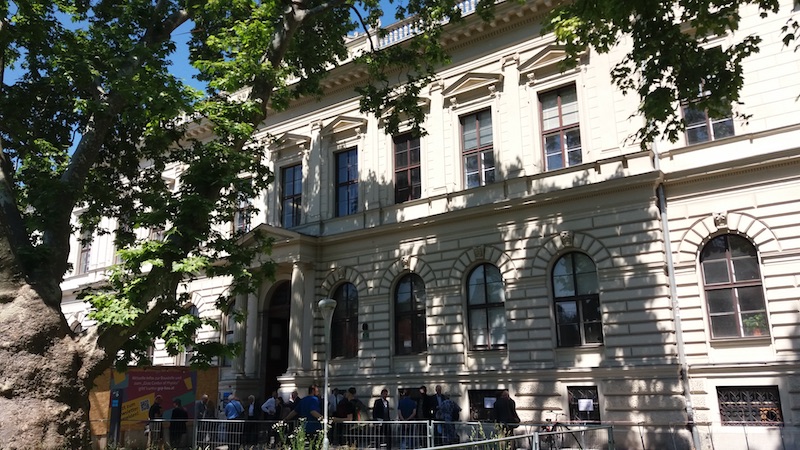
Front side of the institute of physics of the University of Graz - Image credit: Gina Gunaratnam/EPS
Authors: Sonja Draxler and Heinz Krenn
Following the decision on 16 November 2023, the building of the
Institute of Physics at the University of Graz has been honoured with
the distinction of an EPS Historic Site, an award of great importance for
achievements in physics and research. The nomination is the result of an
initiative by the First European Centre for the History of Physics
(ECHOPHYSICS, founded by Peter Maria Schuster).
In a festive
ceremony on 7th June 2024, a commemorative plaque was unveiled by Mairi
Sakellariadou, President of EPS, and Peter Riedler, Rector of Graz
University, on the facade of the physics building at Universitätsplatz
5 in Graz.
The celebration was embedded in a symposium on the historical
construction of the physics building and its leading figure Ludwig
Boltzmann. It was a special honour for us that a great-grandson of Ludwig
Boltzmann, Dieter Fasol, also participated in the symposium and gave a
lecture on “Ludwig Boltzmann, Ilse M. Fasol-Boltzmann and Artificial
Intelligence”.
The physics institute was built between 1872-1876 under the supervision of the physicist August Toepler and
was considered one of the most modern physics research centres at the
time. What was so special about this building? Sun ray corridors running
through the entire ground floor of the building enabled optical
experiments to be carried out in all rooms using heliostats. At the back
side of the building iron-free rooms for galvanometric measurements
were established, and an astronomical observatory was attached to the
building.
August Toepler himself unfortunately could not use this
modern building for his studies as he was appointed to the Royal Saxon
Polytechnic in Dresden and left Graz in 1876. Ludwig Boltzmann was
appointed as his successor. In 1876 he moved into the new institute
building in his second professorship in Graz as full professor of
general and experimental physics.
Besides Ludwig Boltzmann, a
number of other renowned physicists worked, researched and taught in
this building: August Toepler, Albert von Ettingshausen, Walther Nernst,
Svante Arrhenius, Alfred and Kurt Wegener, Viktor F. Hess, Erwin
Schrödinger, Adolf Smekal, Hans Benndorf, Paul Urban, Otto Burkard,
Wilhelm Nordberg, Günther Porod.

Floor plan from the building according to designs by August Toepler - Image credit: W. Höflechner, Archiv der Univ. Graz, post-processed by H. Krenn

Physics Lecture Hall in 1913 - Image credit: K. Rumpf, Publications of the Archive Univ. Graz, vol. 40, post-processed by H. Krenn

Unveiling the memorial plaque by EPS President Mairi Sakellariadou and Rector Peter Riedler on 7th June 2024
Image credit: K. Tzivanopoulos, Univ. Graz, Communications and Public Affairs
Tags:
distinction
EPS Historic Sites
Erwin Schrödinger
Kurt Wegener
Ludwig Boltzmann
University of Graz
Viktor F. Hess
Permalink
|
|
|
Posted By Administration,
Tuesday 5 December 2023
|
Author: Silvia Nicolai
The « Institut de Physique Nucléaire » (IPN) in Orsay, France, was
recently added to the list of the Historic Sites of the European
Physical Society. The laboratory, which recently became part of the
Laboratoire Irène Joliot Curie (IJCLab), received this recognition with
the following motivation: « Initiated in 1956 by Irène and Frédéric
Joliot-Curie as an extension outside Paris of the renowned « Radium
Institute » founded by Marie Curie, where in 1934 they had discovered
artificial radioactivity, and of the « Nuclear Chemistry Laboratory »
founded by Frédéric Joliot, the IPN hosted the first French big
accelerator (a synchrocyclotron) which started operating in 1958. The
creation of the IPN motivated the development of the Orsay scientific
pole. Since then the IPN, which has now become part of the IJCLab
laboratory, played and plays a pivotal role in the study of nuclear and
hadronic physics, and beyond. »
The inclusion of IPN Orsay to the
list of Historic Sites of EPS was celebrated on October 13 2023 in the
Joliot-Curie amphitheater of IJCLab, with a half-day event comprising a
ceremony and a mini-conference. The director of IJCLab, Achille Stocchi,
opened the ceremony with a welcome speech, followed by a few words by
Michel Guidal, deputy vice-president for research of the Paris-Saclay
University and former director of IPN, and by Marcella Grasso, deputy
scientific director of IN2P3 and former director of the Research
Division at IPN. Then Luc Bergé, president of EPS, presented the role
and activities of EPS, and, in particular, described the Historic Sites
program. Finally, a commemorative plaque dedicated to Irène and Frédéric
Joliot-Curie, showcasing the motivation for the recognition and the EPS
logo, was unveiled by Luc Bergé along with Hélène Joliot-Langevin,
daughter of Irène and Frédéric Joliot-Curie, and Alison Bruce, Chair of
the Nuclear Physics Division Board of EPS. Other members of the NPD
Board and the former directors of IPN also took part in the unveiling.
The
mini-conference focused on the history of IPN, from its beginnings to
nowadays. Hélène Joliot-Langevin, emeritus research director at CNRS and
former director of the Physics Division at IPN Orsay, opened the
conference presenting the origins of IPN in the historical context of
the end of World-War II. She outlined, in particular, the efforts her
parents made to reinstate France at the forefront of nuclear-physics
research in Europe, and their political investment for a pacific use of
nuclear power. Then Joel Pouthas, former director of the “Detectors and
R&D” Division at IPN and historian of physics, gave an in-depth
lecture on the history of IPN from its beginnings to recent years, a
history marked by the construction and operation of various
accelerators, made possible by several notable scientists supported by
an outstanding staff of engineers and technicians. The former director
of IPN, Sydney Galès, presented an overview of the scientific highlights
of IPN throughout its more than 60 years of history, which spanned from
low-energy nuclear physics, to hadron and high-energy physics, theory,
radiochemistry, accelerators technology, and medical and societal
applications of nuclear physics. The mini-conference was closed by a
presentation of Silvia Leoni, professor of the Università di Milano and
INFN scientist, which focused on the role of IPN in European low-energy
nuclear physics, with a particular focus on the main achievements of the
last ~15 years as well as on ongoing and future projects and
collaborations.
All the presentations, photos, and a video-recording of the event can be found on the indico page: https://indico.ijclab.in2p3.fr/event/9821/

Luc Bergé, Hélène Joliot-Langevin, and Alison Bruce unveil the commemorative plaque - image credit: Silvia Nicolai

The presidents of EPS and SFP (French Physical Society), the speakers,
the deputy director of IJCLab, the former directors of IPN, and the
members of the NPD-EPS Board pose with the commemorative plaque at the
end of the half-day event.
Tags:
awards
distinction
EPS Historic Sites
France
Frédéric Joliot-Curie
Institut de Physique Nucléaire
IPN
Irène Joliot-Curie
Orsay
Permalink
|
|
|
Posted By Administration,
Tuesday 31 October 2023
Updated: Tuesday 31 October 2023
|

image credit: WikiMedia Commons
Author: Nicola Savic
As a part of the celebration of its 215th anniversary, the
University of Belgrade has placed a commemorative plaque on the Mansion
of Misa Anastasijevic, which has been named as a “Historic Site” by the
European Physical Society (EPS). Professor Milutin Milankovic had his
office in this building which houses today the Rectorate of the
University, where he performed his work dedicated to climate research.
The University of Belgrade together with Association Milutin Milankovic
(AMM), which was the main institutional proponent of this Historic Site,
the EPS and the Serbian Academy of Sciences and Arts (SASA) organized a
small ceremony dedicated to the memory of this famous scientist.
The
plaque declaring the Mansion of Misa Anastasijevic as an “EPS Historic Site”
was unveiled in the courtyard of the Mansion on 15th September by Dr. Luc
Bergé, EPS President, and Mr. Slavko Maksimovic, President of the AMM.
During his opening speech, Dr. Bergé underlined that “…since 2011 the selection committee has received about 130 proposals, and around70 sites in 22 countries have been approved. Thus, theEPS
Historic Sites program is very successful because it is very
attractive. Our selection criteria perfectly apply to Milankovic’ office
at the University of Belgrad, which today will become the first EPS Historic Site in Serbia.”
The
event was well received by the media, since there were five TV teams
and several journalists present for the unveiling. The ceremony was
moderated by Prof. Ratko Ristic, Vice-Rector for International
Cooperation of the University of Belgrade, and Prof. Zoran Knezevic,
President of SASA, who gave an overview of Milankovic’ work. Prof. Goran
Djordjevic, a current member of the EPS Historic Site committee and the
initiator of the proposal for the Milutin Milankovic Historic Site, as
well as members of the SASA, many well-known physicists and
mathematicians from Serbia and renowned university professors were
present at the event, including prof. Ivan Belca, Dean of the Faculty of
Physics, and Aleksandar Bogojevic, PhD, Director of the Institute of
Physics.
Milutin Milankovic (1879-1958) was a doctor of civil
engineering, climatologist, geophysicist, astronomer and promoter of
science, who taught at the University of Belgrade rational mechanics,
celestial mechanics and theoretical physics (1909-1955). He founded an
astronomical theory of climate change on Earth and applied it to the
problem of the ice ages. Milankovic developed his theory of climate
change to solve the problem of the Earth's ice ages during his time at
the Mansion of Misa Anastasijevic. He was the first to accurately
compute the climate response to insolation forcing, providing convincing
evidence that astronomical mechanisms giving rise to the changes of
insolation are three: the secular variations of the eccentricity of the
Earth’s orbit, the precession of the Earth’s axis of rotation, and the
variations of the obliquity of the rotation axis. A convincing proof of
Milankovic’s theory came only after his death, with the results of
CLIMAP project in the mid 1970’s. This brought a well-deserved
recognition to Milankovic‘s achievements. Craters on the Moon and Mars
bear his name, as well as an asteroid (1605 Milankovitch). In addition,
the European Geosciences Union established the Milutin Milankovic Medal for for outstanding research in the field of long-term climate change and modeling.
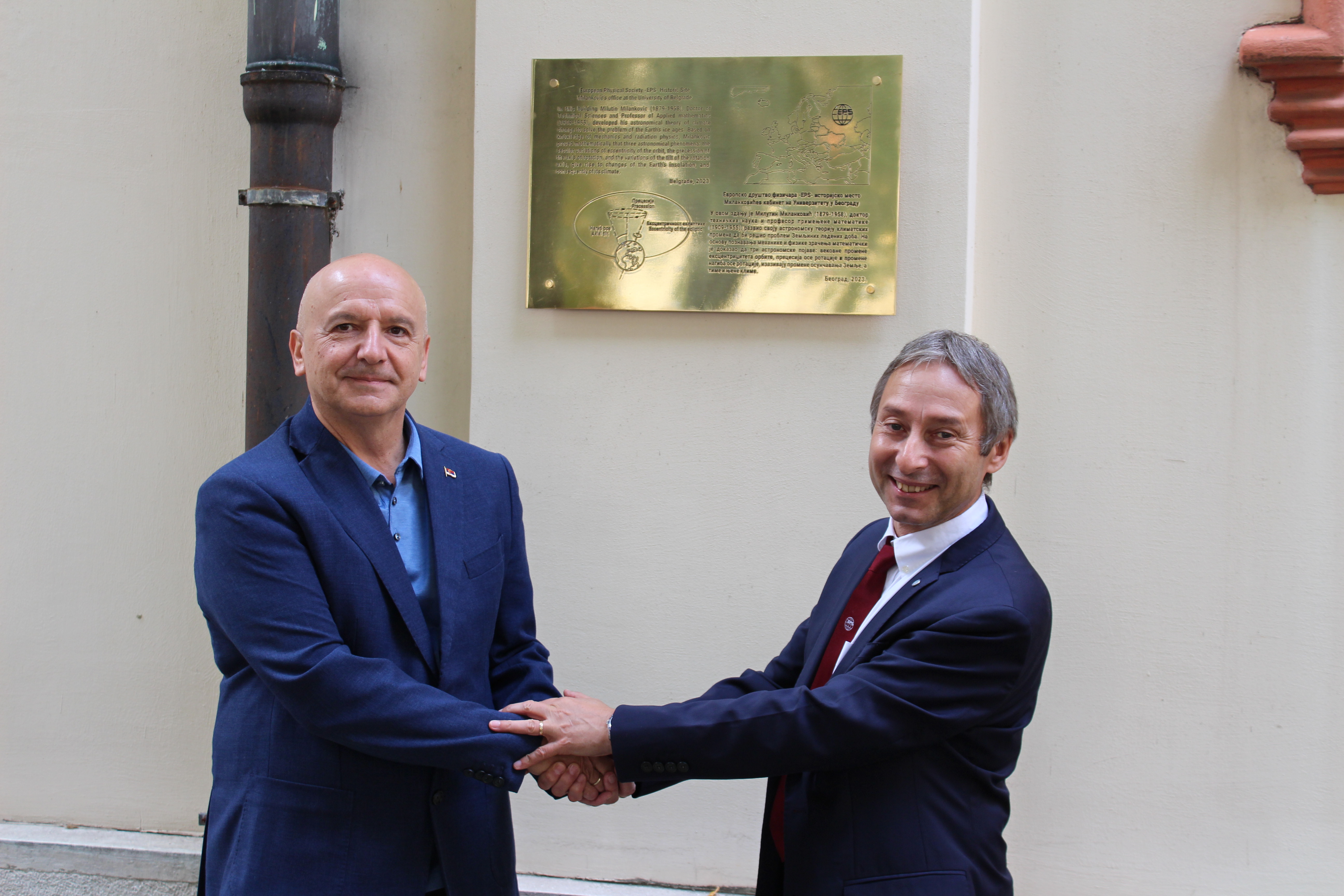
Ratko Ristić, Vice-Rector
for International Cooperation of the University of Belgrade and Luc Bergé, President of the European Physical Society
image credit: Nicola Savic
Tags:
Belgrade
climate research
EPS distinction
EPS Historic Sites
Milutin Milankovic
Misa Anastasijevic
Serbia
Permalink
|
|
|
Posted By Gina Gunaratnam,
Tuesday 10 October 2023
|

The Stachelschützenhaus in Basel, CH, that housed Daniel Bernoulli's Physics Cabinet - images: Gina Gunaratnam/EPS
Author: Gina Gunaratnam
On 22nd September, the former home of the Physics Cabinet of Daniel Bernoulli in Basel was inaugurated as an EPS Historic Site.
During
his time at the University of Basel, Daniel Bernoulli assembled a large
collection of demonstration experiments which he used for teaching and
public lectures. These were housed in the Stachelschützenhaus ("house of
the crossbow men"). The building is still used by the university and is
currently the centre for clinical virology.
The event started at
the University of Basel. Ernst Meyer, Friedrich-Karl Thielemann and
Philipp Treutlein, from the Department of Physics, welcomed the
participants.
Anne Pawsey, Secretary General of the European
Physical Society (EPS), introduced the Society and its Historic Sites
programme. She was followed by Martin Mattmüller, from the
Bernoulli-Euler Society, who described the life of Daniel Bernoulli in a
captivating presentation which included descriptions of the experiments
and quotations from attendees at his lectures.
Stephan Rosswog,
from the University of Hamburg and Stockholm University, showed how
Bernoulli’s theorem remains relevant in the extreme conditions of
neutron star mergers. Rossweg highlighted the importance of
multi-messenger astronomy to obtain sufficient complementary data, as
well as the enormous computational challenge of simulating these complex
processes across huge length and time scales.
After the lectures,
attendees walked to the nearby Stachelschützenhaus, where they were
introduced to the building's current use for research. The assembly
visited a part of the house before gathering in front of the plaque
describing Bernoulli's achievements and where he kept his physics
devices. Anne Pawsey and Philipp Treutlein officially distinguished the
house as the 6th EPS Historic Site in Switzerland.
More info

EPS Secretary General Anne Pawsey explaining the Historic Sites Programme

Martin Mattmüller from the Bernoulli-Euler Society

Stefan Rosswog from the University of Hamburg and Stockholm University

The participants in front of the Stachelschützenhaus

Anne Pawsey and Philipp Treutlein officially inaugurating the new Swiss EPS Historic Site

The plaque in front of the Stachelschützenhaus
Tags:
Bernoulli
Daniel Bernoulli
EPS Historic Sites
History of Physics
hydrodynamics
multi-messenger astronomy
neutrons stars mergers
SPS
Stockhlom University
Swiss Physical Society
University of Basel
University of Hamburg
Permalink
|
|
|
Posted By Administration,
Monday 19 June 2023
Updated: Tuesday 20 June 2023
|
Author: Ionut Topala
On the 22nd May 2023, the Faculty of Physics of the
Alexandru Ioan Cuza University of Iași (UAIC) has been named a “Historic
Site” by the European Physical Society (EPS). The Faculty of Physics in
Iasi is only the second Romanian institution to receive this honour,
after the Magurele Physics Campus in 2017.
A plaque
declaring the Faculty of Physics at the Alexandru Ioan Cuza University
of Iași (UAIC) as an EPS Historic Site was unveiled near the Dean’s
office by the EPS representative, Prof. Goran Djordjević, member of the
EPS HS committee. The messages from Prof. Luc Bergé, EPS President, Prof. Karl Grandin, EPS Historic Sites Committee president, and Prof.
Djordjević himself have been conveyed during the meeting and appreciated
by all participants. “I’m confident that this moment will act as a
model for all next generation of students in Physics here in Iași” said Prof. Gheorghe Popa, former Secretary of State for Research in Romania
and former Rector of Alexandru Ioan Cuza University of Iași.
The
participants were made up of former and actual decision-makers at
Faculty of Physics: Cristian Enachescu, Dean of the Faculty of Physics,
Ionut Topala, Deputy Dean and president of Romanian Physics Society Iasi
Branch, Alexandru Stancu, founder of the Museum of the Faculty, Violeta
Georgescu, former Deputy Dean and Dumitru Luca, former Dean and
Vice-Rector.
The
EPS Historic Site plaque is a symbol to recognise that the city of Iași
has been at the forefront of physics research in the region. As
mentioned on the plaque, some of the scientific landmarks which shaped
the world of physics are “the successful bone X-ray imaging and X-ray
experiments (1896-1906) and the first scientific paper describing the
effect of magnetic fields on chemical reactions (1894), both published
by Dragomir Hurmuzescu. Another landmark is the first correct
calculation of the theoretical magneton, the physical constant still
used to describe the magnetic moment of an electron by Stefan Procopiu
(1912-1913). In addition, since 1849, Teodor Stamati and later Stefan
Procopiu had developed significant observations on geomagnetism in
Romania. The Faculty of Physics has come a long way since then, becoming
a distinct department at UAIC in 1962”.
The
inauguration continued with the ceremony of awarding the title of
Doctor Honoris Causa of the Alexandru Ioan Cuza University of Iași to
Dr. Dumitru Dorin Prunariu, the first and only Romanian to go to perform
a scientific mission in space.
Visitors can now start their
journey with this EPS Historic Site plaque and then continue with the
Physics museum at Alexandru Ioan Cuza University of Iași, there where
pieces of instruments and laboratory equipment dating back from late
nineteenth and early twentieth century can be admired.
More information

The plaque for the EPS Historic Site, Faculty of Physics at Alexandru Ioan Cuza University of Iași, Romania - image credit: Ionut Topala

FLTR: Ionut Topala, Violeta Georgescu, Gheorghe Popa,Alexandru Stancu, Radu Tanasa,
Cristian Enachescu, Dumitru Prunariu,Dumitru Luca, Goran Djordjević

The main building of Alexandru Ioan Cuza University of Iași, Romania, hosting the Faculty of Physics

FLTR: Ionut Topala, Alexandru Stancu, Goran Djordjević, Cristian Enachescu
Tags:
(UAIC)
Alexandru Ioan Cuza
awards
distinction
EPS Historic Sites
Romania
Permalink
|
|
|
Posted By Administration,
Tuesday 13 December 2022
Updated: Friday 16 December 2022
|
Author: IESC
On 7th October 2022, personalities including representatives of the governing bodies and partners of the Institut d'études scientifiques de Cargèse (IESC, CNRS/Univ. Côte d'Azur/Univ. de Corse Pasquale Paoli), gathered for the ceremony to receive the "historic site" distinction from the European Physical Society (EPS). The IESC thus becomes the 6th site to receive this award in France, two years after the Ecole de physique des Houches. On this occasion, a commemorative plaque was unveiled by Luc Bergé, President of the EPS and Guy Wormser, President of the French Physical Society (SFP). "The Institut d'études scientifiques de Cargèse has participated in the history of physics through the great names who have stayed there, but the history continues to be made. The younger generations who are here to learn will later set up projects and remember that they came through Cargèse," said Luc Bergé.
The Institut d'études scientifiques de Cargèse (IESC) received this award for its strong historical involvement in the dissemination of modern knowledge and concepts in physics.
The IESC was born in 1960 from an idea of Maurice Levy, professor at the Faculty of Sciences in Paris and director of the Laboratory of Theoretical Physics at the ENS. 60 years later, more than 700 schools have been organised and about 2000 international students are welcomed every year.
Created to host physics conferences, the IESC has opened up to other disciplines over time, making interdisciplinarity one of its trademarks. The concept behind this school remains the same as that of its "big sister" Les Houches: to offer quality training on contemporary advances, by renowned scientists, in an idyllic setting conducive to reflection and meetings.
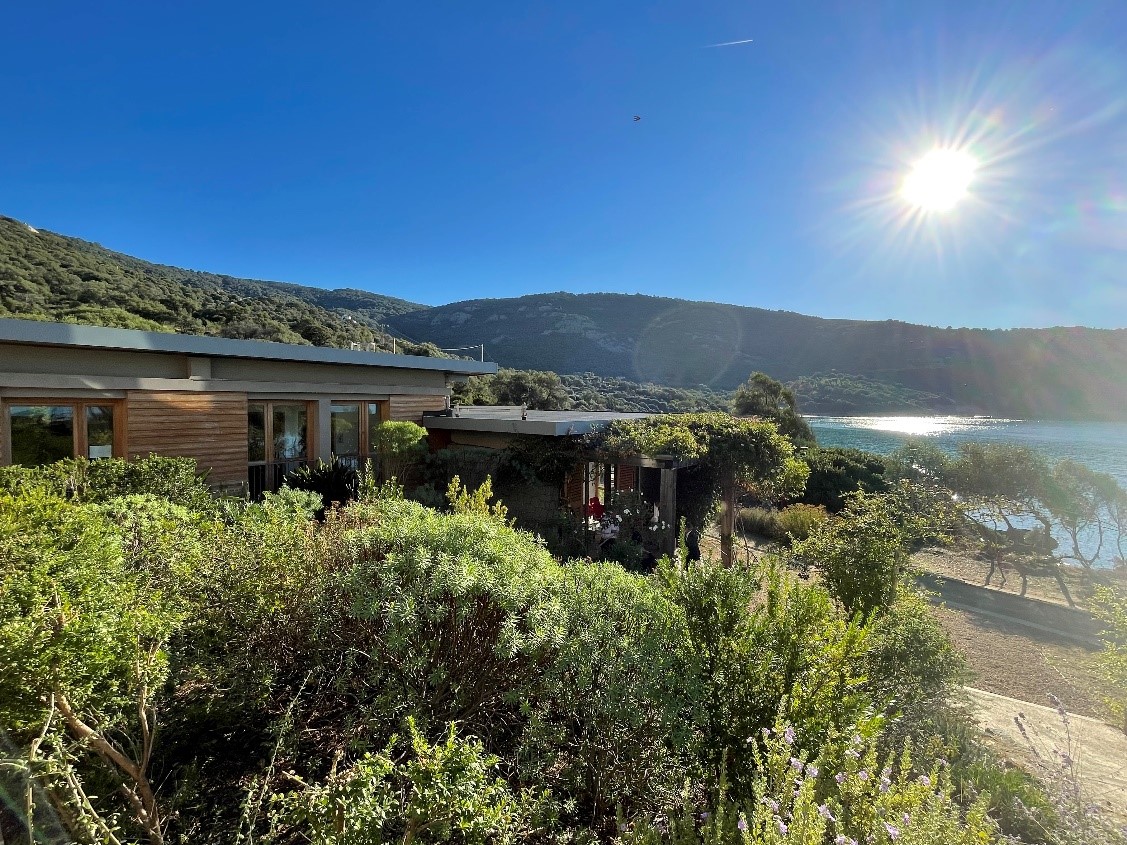
The site where the IESC is located in Corsica, France - image credit: IESC
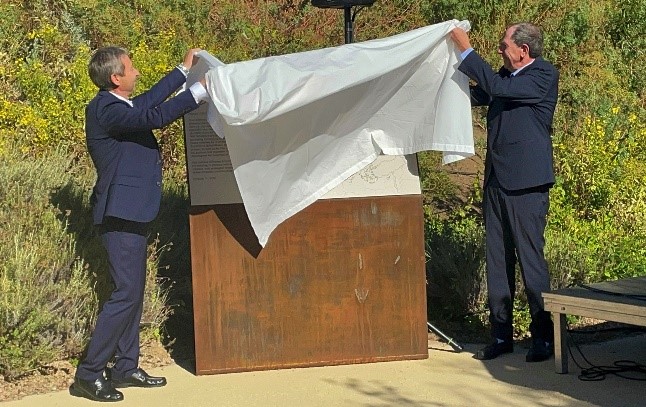
EPS President Luc Bergé unveiling the plaque with SFP President Guy Wormser - image credit: IESC
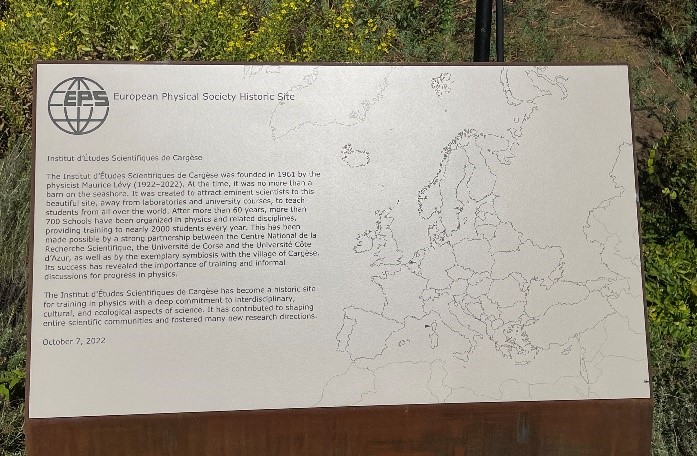
The plaque in front of the IESC building - image credit: IESC
Tags:
Cargèse
EPS Historic Sites
IESC
SFP
Permalink
|
|
|
Posted By Administration,
Thursday 15 September 2022
Updated: Thursday 15 September 2022
|
Author: Andrius Juodagalvis, Lithuanian Physical Society
On 2nd July 2022, Lithuanian enthusiasts of history of physics
gathered in Žeimelis, Lithuania, where the first EPS Historic Site in
the three Baltic states was inaugurated. Having reviewed contributions
of Theodor von Grotthuss (1785-1822), a scientist who lived in the
region in the beginning of the XIX century, the EPS Historic Sites
committee agreed that his laboratory in Gedučiai, near a small town of
Žeimelis, has influenced the development of physics to a comparable
extent as other scientific centres in Europe.
Theodor von
Grotthuss work gained world-wide recognition in 1806, after he published
an article on his theory of electrolysis of water, proposing to base
the electrolysis process interpretation on physical-chemical phenomena.
In his view, the electric field was polarizing molecules in a solution,
and continuous dissociation and recombination of molecules resulted in
the electrolysis effects visible only at the electrodes, where the chain
of pairs was broken. Since 1808 he worked in a laboratory at his
mother's estate in Gedučiai, which is currently a small village close to
Žeimelis in Pakruojis municipality district, Lithuania. Electrolysis
research was supplemented by various studies of interaction of light
with matter, which included phosphorescence and photochemical reactions.
Around 1817 he discovered regularities, that were later called the
Grotthuss-Draper first and second laws of photochemistry. Attempting to
create a unified concept of physical and chemical phenomena based on
charge and molecular constituents, in 1818-1819 Teodor von Grotthuss
concluded that interaction of opposite charges (positive and negative),
depending on conditions, manifests as light, heat, and electricity. The
same publication also proposed that water liquid contains molecules and
their elementary parts even in the absence of an external electric
field. The collective action of molecules that leads to the electric
conductivity of solutions due to proton jumping from one molecule to
another is still called the Grotthuss mechanism.
The EPS Historic
Site sign was placed in a central square of Žeimelis, where the statue
of Teodor von Grotthuss by a sculptor Kęstutis Balčiūnas was erected
earlier this year, in March. The recognition ceremony in Žeimelis was
opened by the chair of the EPS Historic Sites Committee, Karl Grandin.
His speech was translated into Lithuanian by a scientific secretary of
the Lithuanian Physical Society, Andrius Juodagalvis. The chairman of
the EPS selection committee for historic sites congratulated the
participants who witnessed inauguration of the first EPS historic site
in the three Baltic states. He also explained the meaning of distinction
as "a historic site," and highlighted Teodor von Grotthuss'
achievements that contributed towards his recognition by physicists, and
challenged chemists to weigh his influence, since his research topics
are on the borderline between physics and chemistry. Had the Nobel
Prizes been awarded when Grotthuss lived, he might have been awarded
one. Karl Grandin also gifted the local museum with a copy of the last
Theodor von Grotthuss' letter to his colleague in Sweden, Jacob
Berzelius. The president of the Lithuanian Academy of Sciences, Jūras
Banys cherished that a small town of Žeimelis joined the league of other
famous places in Europe, where the foundations of modern physics were
laid. Other speakers of the official ceremony were the president of the
Grotthuss' Foundation at the Lithuanian Academy of Sciences, Aivaras
Kareiva, the initiator of the EPS historic site application and a former
president of the Lithuanian Physical Society, Juozas Vidmantis Vaitkus,
the president of the Lithuanian Physics Teachers' Asociation, Rigonda
Skorulskienė, the dean of the Faculty of Physics at Vilnius University,
Juozas Šulskus, and the mayor of the Pakruojis municipality district
Saulius Margis. At the end of the ceremony, Karl Grandin declared the
EPS historic site in Žeimelis to be officially inaugurated. The entire
ceremony was started and finalized with live saxophone melodies.
The Lithuanian Physical Society
is grateful to the EPS Historic Site committee for recognition of
Theodor von Grotthuss research results, and the Pakruojis district
municipality for providing local support. Theodor von Grotthuss
scientific contributions are described following the EPS historic site
application written by J. V. Vaitkus and A. Kareiva, and an overview
article by B. Jaselskis et al, Bull. Hist. Chem. 32 (2007) 119-128.

Official participants of the EPS Historic Site inauguration in Žeimelis, Pakruojis municipality district, Lithuania.
Photo by A. Skorulskas
More info
Tags:
distinction
Electrolysis
EPS Historic Site
EPS Historic Sites
light
Lithuania
Lithuanian Physical Society
Theodor von Grotthuss
Permalink
|
|
|
Posted By Administration,
Thursday 15 September 2022
Updated: Thursday 15 September 2022
|
Author: Noortje de Graaf
We proudly announce the latest EPS Historic Site in the Netherlands: the
former Zeeman laboratory in Amsterdam. On 25th May, Pieter Zeeman's
birthday, the plaque on the building was unveiled by EPS Vice-President
Petra Rudolf. The Zeeman laboratory was opened in 1923 at Plantage
Muidergracht 4 in Amsterdam, it was specially equipped for experiments
that were carried out in the group of Nobel Prize Laureate Pieter
Zeeman. Pieter Zeeman was awarded the Nobel Prize in 1902 together with
Hendrik Lorentz. Today the building is inhabited, the laboratory has
been converted into several apartments. The unveiling was actually
planned in 2021 in the context of 100 years of Netherlands’ Physical
Society, but had to be postponed until 2022 due to Covid-19. The other
EPS Historic Sites in the Netherlands are Kamerlingh Onnes Laboratory in
Leiden, the NatLab in Eindhoven and Sonnenborgh in Utrecht.
Members of the Van der Waals-Zeeman laboratory of the University of Amsterdam made this short movie about the work of Pieter Zeeman and their own work.

photos: NNV
More about the EPS Historic Sites programme
Tags:
distinction
EPS Historic Sites
Netherlands
NNV
Pieter Zeeman
Permalink
|
|
|
|